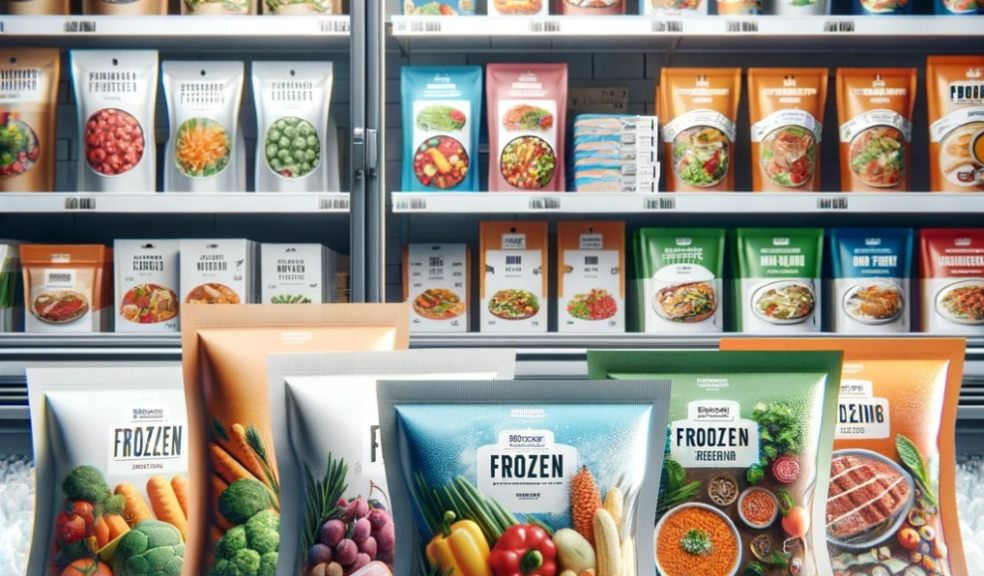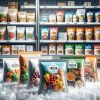
How to Package Frozen Food for Sale and Shipping
Many products are offered frozen nowadays. Fish, seafood, semi-finished and perishable products, ice cream, and meat come in a frozen form on store shelves. While this type of good storage and sale is beneficial due to perfect shelf life preservation, it requires satisfying particular conditions. So, below, we’re going to consider how to package frozen food for sale to please consumers and prolong its shelf life.
When selecting a proper type of cover for frozen products, manufacturers should focus on such criteria as material physical properties, customer satisfaction, and its impacts on food and shelf life.
Common Challenges of Shipping Frozen Foods
When considering the issue of frozen food packaging and storage, such wrappers face a number of challenges. These are:
- Temperature extremes. Constant exposure to extremely high or low temperatures can affect both products and wrappers, causing premature spoilage and loss of barrier properties for packaging. Special covers are designed to withstand extremely low temperatures, but make sure that sudden climatic changes can worsen their physical properties. Make sure to guarantee proper delivery and use trusted courier services to guarantee satisfying shipping conditions to prevent spoilage.
- Humidity. This environmental criterion is another popular threat to frozen products. Thus, such coolants as gel packs are widely used to prevent goods from melting during transit.
- Spoilage risk. This threat is high since violation of shipment conditions leads to food melting and spoilage, which means extra expenses and loss of reputation for vendors. It’s essential to use insulated boxes and refrigerated systems to deliver fresh products to counters.
Not all covers can withstand the mentioned challenges, which is why the selection of appropriate packaging for frozen products requires a particular approach. This is why it’s vital to know how to package frozen food for shipping and pay due attention to this aspect.
Businesses should choose trusted contractors like Uniflex to guarantee frozen food packaging supplies. Uniflex comes as a reputable producer of wrappers. The company is expertized in designing customizable solutions at affordable costs for each client. Covers are high-quality and satisfy all requirements of the food industry.
Essential Elements in Frozen Food Packaging
The right wrapper for frozen products should be very durable and meet particular physical requirements. Namely, packages should be:
- Moisture resistance. If ice or food starts melting, the package should prevent moisture from leaving saturating through it. Covers should be resistant enough to keep moisture inside as well as prevent external moisture from entering the package.
- Strength. Wrappers should be resistant to tear, puncture, etc. Fish or seafood can have sharp edges, which can puncture the cover. Make sure to select highly durable materials that preserve integrity during shipments and storage.
- FDA compliance. Covers should be safe and do not emit poisonous substances during storage and transportation. That is, components of containers should not come into reaction with food.
- Low-temperature resilience. Since frozen products are stored under low temperatures for months, wrapper materials should possess excellent resilience to temperature extremes without quality deterioration.
Judging by these criteria, the following packages come as the most suitable options to pack frozen food for shipping. These are flexible bags, shrink film, glass, wax-coated cardboard, and aluminum. Moreover, flexible wrappers take the leading place since they can take any shape, possess excellent barrier properties, and are incredibly durable.
How to Pack Frozen Foods for Shipping?
Before your frozen products are ready for transit, they should pass a long way. The process includes several stages of preparation for shipment. Here is a sequence of procedures to go through. We mentioned the main tips on how to pack cold food for shipping:
- Pack products properly. Most products consist of several layers of wrappers. Bubble wrap or watertight plastic bags are used to avoid damage and spoilage when being in transit. The addition of this layer comes as an extra guarantee to ensure increased protection.
- Select a suitable insulated box. The use of insulated boxes is justified to prevent product movement around a truck during transportation. It also helps preserve a cooler atmosphere on the way.
- Put coolants into insulated boxes. These can be gel packs or dry ice. Note that dry ice is preferable for frozen products, while gel packs are usually used for cooled food. Make sure to discuss this point with a carrier since dry ice requires following particular guidelines during transportation.
- Seal boxes and attach the necessary labels, such as class of product, destination, etc.
- Place insulated boxes into a shipping container.
Note that although you use insulated boxes or other solutions, put products tightly to avoid damage and be sure that it is packed safely.
Considerations for Effective Food Packaging
Besides, let’s highlight the key factors that make wrappers effective. Covers are used to not only pack frozen food to ship. They also perform other functions. Wrappers are used as a marketing tool for managing consumer behavior. The ability to attract attention stimulates sales and increases brand recognition. Covers should provide useful information and convey a brand message for smooth communication with consumers. The ability to ensure product safety during storage and transportation is critical. Finally, wrappers are used to showcase the product.
No business can go without packing its food since 90% of goods are placed on store shelves. When dealing with frozen products, the process requires particular consideration. Now, you know how to package cold food for shipping and prevent its spoilage. Select a suitable option for your products and enjoy positive interaction with customers.

















